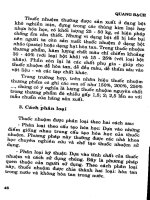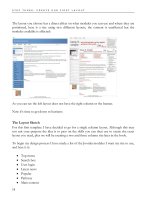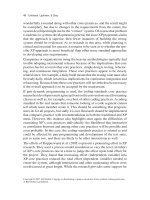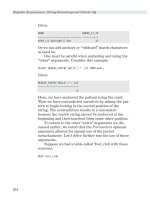Ajax in Oracle JDeveloper phần 3 doc
Bạn đang xem bản rút gọn của tài liệu. Xem và tải ngay bản đầy đủ của tài liệu tại đây (1.82 MB, 23 trang )
2.5 Processing an Ajax Response 35
response.sendRedirect(“error.jsp”);
} catch (SQLException e) {
response.sendRedirect(“error.jsp”);
}
}
}
2.5 Processing an Ajax Response
In this section the Ajax XML response is retrieved and the input web page
updated to indicate the validity of the Catalog Id value and the input fields
are autocompleted if the Catalog Id is not valid. If the readyState
property value is 4, which corresponds to a completed
XMLHttpRequest, and the status property value is 200, which
corresponds to HTTP status “OK”, the processResponse() function
gets invoked. In the processResponse function, obtain the value for
the responseXML property.
var xmlMessage=xmlHttpRequest.responseXML;
The responseXML object is an XML DOM object. Obtain the value
of the <valid/> element using
getElementsByTagName(String) method.
var
valid=xmlMessage.getElementsByTagName(“valid”)[0].fir
stChild.nodeValue;
If the
<valid/>
element value is true, set the HTML of a div element
in the Catalog Id field row to “Catalog Id is Valid”. Enable the submit
button in the input form.
if(valid==”true”){
var
validationMessage=document.getElementById(“validation
Message”);
validationMessage.innerHTML = “Catalog Id is Valid”;
document.getElementById(“submitForm”).disabled =
false;
}
If the <valid/> element value is false, set the HTML of the div
element in Catalog ID field row to “Catalog Id is not Valid”. Disable the
submit button, and set the values of the other input fields.
36 2 Developing an Ajax Web Application
if(valid==”false”){
var
validationMessage=document.getElementById(“validation
Message”);
validationMessage.innerHTML = “Catalog Id is not
Valid”;
document.getElementById(“submitForm”).disabled =
true;
}
The input.js JavaScript file is listed below.
function validateCatalogId(){
var xmlHttpRequest=init();
function init(){
if (window.XMLHttpRequest) {
return new XMLHttpRequest();
} else if (window.ActiveXObject) {
return new
ActiveXObject(“Microsoft.XMLHTTP”);
}
}
var
catalogId=document.getElementById(“catalogId”);
xmlHttpRequest.open(“GET”,
“validateForm?catalogId=”+
encodeURIComponent(catalogId.value), true);
xmlHttpRequest.onreadystatechange=processRequest;
xmlHttpRequest.send(null);
function processRequest(){
if(xmlHttpRequest.readyState==4){
if(xmlHttpRequest.status==200){
processResponse();
}
}
}
function processResponse(){
var xmlMessage=xmlHttpRequest.responseXML;
var
valid=xmlMessage.getElementsByTagName(“valid”)[0].
firstChild.nodeValue;
if(valid==”true”){
var
validationMessage=document.getElementById(“validatio
nMessage”);
validationMessage.innerHTML = “Catalog Id is Valid”;
2.5 Processing an Ajax Response 37
document.getElementById(“submitForm”).disabled =
false;
var
journalElement=document.getElementById(“journal”);
journalElement.value = “”;
var
publisherElement=document.getElementById(“publisher”
);
publisherElement.value = “”;
var
editionElement=document.getElementById(“edition”);
editionElement.value = “”;
var titleElement=document.getElementById(“title”);
titleElement.value = “”;
var authorElement=document.getElementById(“author”);
authorElement.value = “”;
}
if(valid==”false”){
var
validationMessage=document.getElementById(“validatio
nMessage”);
validationMessage.innerHTML = “Catalog Id is not
Valid”;
document.getElementById(“submitForm”).disabled =
true;
var
journal=xmlMessage.getElementsByTagName(“journal”)[0
].firstChild.nodeValue;
var
publisher=xmlMessage.getElementsByTagName(“publisher
”)[0].firstChild.nodeValue;
var
edition=xmlMessage.getElementsByTagName(“edition”)[0
].firstChild.nodeValue;
var
title=xmlMessage.getElementsByTagName(“title”)[0].fi
rstChild.nodeValue;
var
author=xmlMessage.getElementsByTagName(“author”)[0].
firstChild.nodeValue;
var
journalElement=document.getElementById(“journal”);
journalElement.value = journal;
var
publisherElement=document.getElementById(“publisher”
);
publisherElement.value = publisher;
38 2 Developing an Ajax Web Application
var
editionElement=document.getElementById(“edition”);
editionElement.value = edition;
var titleElement=document.getElementById(“title”);
titleElement.value = title;
var authorElement=document.getElementById(“author”);
authorElement.value = author;
}
}
}
To the input.jsp add input fields for journal, publisher, edition, title, and
author and also add a Submit button. The input.jsp is listed below.
<html>
<head>
</head>
<body>
<h1>Ajax Web Application</h1>
<form name=”validationForm” action=”validateForm”
method=”post”>
<table>
<tr><td>Catalog Id:</td><td><input type=”text”
size=”20”
id=”catalogId”
name=”catalogId”
onkeyup=”validateCatalogId()”></td>
<td><div id=”validationMessage”></div></td>
</tr>
<tr><td>Journal:</td><td><input type=”text”
size=”20”
id=”journal”
name=”journal”></td>
</tr>
<tr><td>Publisher:</td><td><input type=”text”
size=”20”
id=”publisher”
name=”publisher”></td>
</tr>
<tr><td>Edition:</td><td><input type=”text”
size=”20”
id=”edition”
name=”edition”></td>
</tr>
<tr><td>Title:</td><td><input type=”text”
size=”20”
id=”title”
2.5 Processing an Ajax Response 39
name=”title”></td>
</tr>
<tr><td>Author:</td><td><input type="text"
size=”20”
id=”author”
name=”author”></td>
</tr>
<tr><td><input type=”submit”
value=”Create Catalog”
id=”submitForm”
name=”submitForm”></td>
</tr>
</table>
</form>
</body>
</html>
Next, include the JavaScript file input.js to the JSP file input.jsp.
Position the cursor in the <head></head> element in input.jsp and drag
and dropt input.js from the
Application Navigator
. A <script/>
element gets added to input.jsp. Modify the <script/> element to add a
type
attribute.
<script language=”JavaScript” type=”text/javascript”
src=”input.js”></script>
We also need to modify the catalog.jsp, which is the JSP that gets
displayed if a catalog entry gets created. Add the following scritplet to
catalog.jsp.
<%out.println(“Catalog Entry Created”); %>
Similarly, to the error.jsp add scriptlet that outputs an error message.
<%out.println(“Error in creating Catalog Entry”); %>
Select File>Save All to save all the Ajax application files. Next, we
shall run the Ajax web application in JDeveloper 11g. Right-click on the
input.jsp file in Application Navigator, and select Run as shown in Fig.
2.13.
40 2 Developing an Ajax Web Application
Fig. 2.13 Running Ajax Web Application
The input form gets displayed. Start adding data to Catalog Id field. An
XMLHttpRequest gets sent to the server to verify the validity of the
data being added. If the Catalog Id field value is valid, a “Catalog Id is
Valid” message gets displayed as shown in Fig. 2.14.
Fig. 2.14
Validating Catalog Id
2.5 Processing an Ajax Response 41
An XMLHttpRequest request gets sent with each modification to
the Catalog Id input field as shown in Fig. 2.15.
Fig. 2.15 Dynamic Validation
If a value is added that is already defined in the database, a “Catalog Id
is not Valid” message gets displayed and the
Submit
button gets disabled
as shown in Fig. 2.16.
42 2 Developing an Ajax Web Application
Fig. 2.16 Non-Valid Catalog Id
Specify a Catalog Id field value that is valid and click on Create
Catalog button to add a catalog entry as shown in Fig. 2.17.
Fig. 2.17
Creating a Catalog Entry for a Valid Catalog Id
2.5 Summary 43
The form gets posted to the server with POST method, because the
method specified in <form/> element is POST. A catalog entry for the
specified field values gets added to the database. If subsequently, a Catalog
Id value of Catalog4 is re-specified, an XMLHttpRequest gets sent to
the server, and the response has <valid/> element set to false. The
validation message gets displayed to indicate that the Catalog Id is not
valid as shown in Fig. 2.18.
Fig. 2.18 A Catalog Id becomes non-valid after a catalog entry is created
2.5 Summary
The Ajax technique provides dynamic validation of data added to an input
form using the XMLHttpRequest object. Ajax is a technique, therefore
a combination other than JavaScript, DOM and Servlet may be used. For
example, the server side application may be a PHP script instead of a
servlet. In this chapter we used Ajax to validate an input form in
JDeveloper 11g. HTTP Servlet is used on the server side.
3 Less JavaScript with Prototype
3.1 Introduction
In the previous chapter we discussed the procedure to create an Ajax web
application. The reader might have noticed that the client script included a
lot of JavaScript. Prototype is a JavaScript library for developing dynamic
web applications. The objective of the prototype library is to reduce the
JavaScript code with prototype functions and to provide Ajax functionality
with Ajax.Request and Ajax.Updater classes. In a previous
chapter we developed an Ajax application to validate an input form. The
same application could be developed with the Prototype library, as we
shall discuss in this chapter.
3.2 Overview of Prototype
The Prototype library provides various utility functions to reduce
JavaScript code, and provides Ajax classes to send an
XMLHttpRequest request. Prototype also provides functions for DOM
processing, form processing, and event processing. We shall discuss the
main Prototype functions and classes next.
3.2.1 $() function
The $() function is used to replace the
document.getElementById() function. For example a non-
prototype JavaScript retrieves a form element formDiv as follows.
var formDiv =document.getElementById(“formDiv”);
The formDiv element may be retrieved with prototype as follows.
var formDiv =$('formDiv');
46 3 Less JavaScript with Prototype
3.2.2 $F() function
The $F()function is used to retrieve the value of a form element. For
example, a non-prototype JavaScript obtains a form field value as follows.
var field1=document.getElementById(“field1”).value;
The $F() function reduces the code to retrieve the form filed value as
shown below.
var field1=$F('field1');
3.2.3 $A() function
The $A()function is used to create an Array object from a node list or an
enumerable list. For example, an Array object may be created from a node
list object and the Array object navigated to retrieve node values. In the
following listing the HTML value of the first journal node in an XML
document is retrieved with the $A() function.
var nodeList=xmlMessage.getElementsByTagName
(“journal”);
var journalValue=$A(nodeList).first().innerHTML;
3.2.4 $H() function
The $H()function converts enumerations into enumerable Hash objects.
For example, variable journal is an enumeration of journals.
var journal={first: Oracle Magazine, second: ONJava,
third: AJAX Magazine};
The enumeration may be transformed into a hash with the $H()
function.
var journals=$H(journal);
3.2.5 $R() function
The $R()function is used to represent an ObjectRange object. For
example, the following ObjectRange object may be represented with
the $H() function.
ObjectRange range=new ObjectRange(10, 25, false);
The corresponding $R() function representation is as follows.
var range=$R(10, 25, false);
3.2 Overview of Prototype 47
3.2.6 $w() Function
The $w()function creates an array from a string using the whitepaces in
the string as delimiters. For example, the following Array, catalogIds,
may be created from a string that consists of Catalog Ids delimited by
whitespace using the $w() function.
var catalogIds=$w(“catalog1 catalog2 catalog3”);
The catalogIds array may be represented as follows.
[‘catalog1’, ‘catalog2’, ‘catalog3’]
3.2.7 Try.these function()
The Try.these()function tries a sequence of functions until one of the
function runs. For example, different browsers create an
XMLHttpRequest differently. Try.these() function may be used to
create an XMLHttpRequest object as shown in following listing.
function getXMLHttpRequest(){
return Try.these(
function() {return new XMLHttpRequest();},
function() {
return new ActiveXObject(“Microsoft.XMLHTTP”);}
);}
3.2.8 Ajax.Request Class
The Prototype library provides the Ajax.Request class to send an
XMLHttpRequest request. The The Ajax.Request constructor may
be used to create an Ajax.Request object.
Ajax.Request ajaxRequest=new
Ajax.Request(url,options);
The options value may be specified with a JavaScript Object
Notation (JSON). For example, an Ajax.Request object may be
created that sends an XMLHttpRequest to a servlet url, which includes
a userid parameter.
var userid=$F('userid');
var url = 'servletURL';
var pars = 'userid=' + userid;
var myAjax = new Ajax.Request(
url, {method: 'get',
parameters: pars, onComplete: showResponse});
48 3 Less JavaScript with Prototype
The url specifies the servlet url to which the request is sent. The
options are specified as a JSON; the method property specifies that
the request be sent using HTTP GET method; the default method is POST.
The method value (get/post) is required to be specified in lowercase.
The parameters property specifies the parameters to be sent with the
url. The onComplete property specifies the function to be invoked
when the request is complete. Similarly,
onLoading
,
onLoaded
, and
onInteractive property functions may be specified. The onLoading
property represents the state when an
XMLHttpRequest
has been
initiated, but the request has not yet been sent. The onLoaded property
represents the state when the request has been sent, but a response has not
yet been received. The onInteractive property represents the state
when the some of the response has been received. The onComplete
property represents the state when all of the response has been recieved.
The onComplete property function, or a property function representing
some other state of the request, is invoked by an argument containing the
XMLHttpRequest object and another argument containing the response
HTTP header. Some of the commonly used Ajax.Request options are
discussed in Table 3.1.
Table 3.1 AjaxRequest Options
Property Description
method Specifies method of HTTP request.
Default value is ‘post’. Type is string.
p
arameters List of parameters that are sent with the
HTTP request. Type is string.
asynchronous Specifies if the XMLHttpRequest be sent
asynchronously. Default is true.
p
ostBody If HTTP request method is ‘post’,
specifies the request’s body.
requestHeaders Specifies an array of HTTP headers to be
sent with the request.
onLoading, onLoaded, onInteractive,
onComplete
Specifies the functions that are invoked
at various stages of the request. Recieves
an argument representing the
XMLHttpRequest and an argument
representing the response header.
3.2 Overview of Prototype 49
Table 3.1
(continued)
Property Description
onSuccess, onFailure,
onException
Specifies the function to be invoked
when AJAX request completes
successfully, or fails, or generates an
exception. Similar to onComplete
function, the function recieves an
argument representing the
XMLHttpRequest and an argument
representing the response header.
3.2.9 Ajax.Updater Class
Ajax.Updater class is a sub class of Ajax.Request class and is
used to update a specified DOM element with an XMLHttpRequest
response. The Ajax.Updater constructor may be used to create an
Ajax.Updater object as shown below.
var ajaxRequest=new Ajax.Updater(container, url,
options);
The container parameter may be an element id, an element object,
or an object with two properties; object.success and
object.failure. The object.success element is used for
updating if the Ajax call succeeds and the object.failure element is
used if the Ajax call fails. The url parameter specifies the url to which
the request is sent. The options parameter specifies the Ajax options,
which are the same as for Ajax.Request class. In addition to the
Ajax.Request
options, an insertion class may be specified with
insertion property. Insertion class value may be
Insertion.Before
(adds HTML before the element),
Insertion.After(adds HTML after the element),
Insertion.Top
(adds HTML as a first child of the element), or
Insertion.Bottom(adds HTML as the last child of the element).
Another option that may be specified with Ajax.Updater is
evalScripts, which indicates if scripts shall be evaluated when the
response is received. Default value of evalScripts is false. For
example, send an XMLHttpRequest with Ajax.Updater to update a
form element, userid, with the response HTML.
var ajaxRequest = new Ajax.Updater('userid', url,
{method: 'get',
parameters: pars});
50 3 Less JavaScript with Prototype
3.2.10 Ajax.PeriodicalUpdater Class
The Ajax.PeriodicalUpdater class is similar to Ajax.Updater
class and is used to update a form element periodically. The frequency
with which the element is updated is specified with the frequency
option. The constructor for Ajax.PeriodicalUpdater is the same as
Ajax.Updater. For example, update a validationMessage div
periodically.
Var ajaxRequest= new Ajax.PeriodicalUpdater
('validationMessage', url,
{frequency: '2',
method: 'get',
parameters: pars
});
3.3 Installing Prototype
We shall be using the same application that we developed in the previous
chapter and add prototype functionality to the user interface. Download the
latest version of prototype libray
1
. Copy prototype.js to the public_html
directory of the Ajax project in JDeveloper 11g. The prototype.js file
should be in the same directory as the input.jsp as shown in Fig. 3.1.
1
Prototype Library-
3.4 Configuring Prototype in AJAX Web Application 51
Fig. 3.1
Prototype Application Directory Structure
3.4 Configuring Prototype in AJAX Web Application
In this section we shall add prototype library functions and classes to the
Ajax application input.jsp. To access the prototype.js library add the
following <script/> element to input.jsp.
<script src=”prototype.js” type=”text/javascript”>
</script>
In the Ajax application version without the prototype library, the
catalogId field is retrieved with get getElementById() function
and the value is retrieved with value attribute.
var
catalogId=document.getElementById(“catalogId”).value;
Retrieve the catalogId value with prototype function $F().
var catalogId=$F('catalogId');
52 3 Less JavaScript with Prototype
In the non-prototype version, the DOM elements are retrieved with
getElementById() function. For example the
validationMessage div is retrieved as follows.
var validationMessage=
document.getElementById(“validationMessage”);
Replace the getElementById() function with prototype function
$().
var validationMessage=$('validationMessage');
In the non-prototype version an XMLHttpRequest object is created
with the XMLHttpRequest constructor or the ActiveXObject
constructor. The callback method is registered with the
XMLHttpRequest object and the HTTP request sent to the server. The
callback method is invoked when the request state changes and when the
request is complete the HTTP response is processed.
var xmlHttpRequest=init();
function init(){
if (window.XMLHttpRequest) {
return new XMLHttpRequest();
} else if (window.ActiveXObject) {
return new
ActiveXObject(“Microsoft.XMLHTTP”);
}
}
xmlHttpRequest.onreadystatechange=processRequest;
xmlHttpRequest.send(null);
function processRequest(){
if(xmlHttpRequest.readyState==4){
if(xmlHttpRequest.status==200){
processResponse();
}
}
}
The prototype library provides Ajax.Request class to send an
XMLHttpRequest request. Define a variable for servlet url and a
variable for url parameters.
var catalogId=$F('catalogId');
var url = 'validateForm';
var pars ='catalogId='+catalogId;
3.4 Configuring Prototype in AJAX Web Application 53
Create an Ajax.Request object with the servlet url. Set the options
property method to ‘get’. Specify the parameters options property
and set the asynchronous property to true. Specify the callback
method with the onComplete property. The XMLHttpRequest gets
created and sent to the specified url. When the request is complete, the
showResponse function gets invoked. The function registered with the
onComplete
property gets invoked with an argument containing the
XMLHttpRequest object and an argument containing the HTTP
response header.
var ajaxRequest = new Ajax.Request(
url,
{
method: 'get',
parameters: pars,
asynchronous: true,
onComplete: showResponse
});
}
function showResponse(xmlHttpRequest, responseHeader)
{//Process Http response and update input form
}
The showResponse function retrieves the XML response from the
server and updates the input form.
var xmlMessage = xmlHttpRequest.responseXML;
The input.js with JavaScript code replaced with prototype library
functions and Ajax.Request class is listed below.
function validateCatalogId(){
var catalogId=$F('catalogId');
var url = 'validateForm';
var pars ='catalogId='+catalogId;
var ajaxRequest = new Ajax.Request(
url,
{
method: 'get',
parameters: pars,
asynchronous: true,
onComplete: showResponse
});
}
function showResponse(xmlHttpRequest, responseHeader)
{
var xmlMessage = xmlHttpRequest.responseXML;
54 3 Less JavaScript with Prototype
var
valid=xmlMessage.getElementsByTagName(“valid”)[0].fir
stChild.nodeValue;
if(valid==”true”){
var validationMessage=$('validationMessage');
validationMessage.innerHTML = “Catalog Id is Valid”;
$('submitForm').disabled = false;
var journalElement=$('journal');
journalElement.value = “”;
var publisherElement=$('publisher');
publisherElement.value = “”;
var editionElement=$('edition');
editionElement.value = “”;
var titleElement=$('title');
titleElement.value = “”;
var authorElement=$(‘author’);
authorElement.value = “”;
}
if(valid==”false”){
var validationMessage=$('validationMessage');
validationMessage.innerHTML = “Catalog Id is not
Valid”;
$(‘submitForm’).disabled = true;
var
journal=xmlMessage.getElementsByTagName(“journal”)[0]
.firstChild.nodeValue;
var
publisher=xmlMessage.getElementsByTagName(“publisher”
)[0].firstChild.nodeValue;
var
edition=xmlMessage.getElementsByTagName(“edition”)[0]
.firstChild.nodeValue;
var
title=xmlMessage.getElementsByTagName(“title”)[0].fir
stChild.nodeValue;
var
author=xmlMessage.getElementsByTagName(“author”)[0].f
irstChild.nodeValue;
var journalElement=$('journal');
journalElement.value = journal;
var publisherElement=$('publisher');
publisherElement.value = publisher;
var editionElement=$('edition');
editionElement.value = edition;
var titleElement=$('title');
titleElement.value = title;
3.4 Configuring Prototype in AJAX Web Application 55
var authorElement=$('author');
authorElement.value = author;
}
}
Replace the input.js in the Ajax web application with the input.js with
the Prototype functions and classes. Run the input.jsp in JDeveloper 11g to
generate the same output as the non-prototype version of the Ajax
application. Right-click on input.jsp and select
Run
as shown in Fig. 3.2.
Fig. 3.2
Running Ajax Prototype Application
The catalog entry form gets displayed .Specify a catalog Id. An HTTP
request gets sent to the server with the XMLHttpRequest object.
Instructions about the validity of the Catalog Id get sent back to the
browser, all without posting the web page to the server. A message gets
displayed about the validity of the Catalog Id. For example, if a Catalog Id
value is specified that is not already in the database message “Catalog Id is
Valid” gets displayed as shown in Fig. 3.3.
56 3 Less JavaScript with Prototype
Fig. 3.3 Validating Catalog Id
Next, specify a Catalog Id value that is already in the database,
catalog1 for example. A message gets displayed, “Catalog Id is not
Valid”. The form fields for the specified Catalog Id get filled with data
from the database and the Create Catalog button gets disabled as shown
in Fig. 3.4.
3.4 Configuring Prototype in AJAX Web Application 57
Fig. 3.4 Non Valid Catalog Id
To add a catalog entry, specify a Catalog Id that is not already in the
database , specify the field values and click on Create Catalog button as
shown in Fig. 3.5.
Fig. 3.5 Creating a Catalog Entry
58 3 Less JavaScript with Prototype
A new catalog entry gets created.
3.5 Updating a DOM Element with Ajax.Updater
The prototype library provides another class, Ajax.Updater to update a
DOM element’s contents with the HTML from an XMLHttpRequest
response. As an example we shall update the validationMessage
element in the input form with HTML response from the server using the
Ajax.Updater class. Create an Ajax.Updater object and specify the
DOM element to update, the servlet url, and options parameters as shown
below.
function validateCatalogId(){
var catalogId=$F('catalogId');
var url = 'validateForm';
var pars ='catalogId='+catalogId;
var ajaxRequest = new Ajax.Updater
('validationMessage',
url,
{
method: 'get',
parameters: pars
});
}
Replace the validateCatalogId function in input.js in Ajax web
application with the validateCatalogId function that has the
Ajax.Updater
class object to send the Ajax request. If an
onComplete function is specified the function gets invoked after the
DOM element specified to be updated has been updated. Also modify the
FormValidationServlet servlet to generate a text response with
which the
validationMessage
div’s contents are to be updated with.
In the FormValidationServlet servlet, replace the if-else block
that generates the Ajax response with the following code.
if (rs.next()) {
out.println(“Catalog Id is not Valid”);
} else {
out.println(“Catalog Id is Valid”);}
Right-click on input.jsp and select Run in JDeveloper 11g to produce
the input form. Specify a Catalog Id field value. An XMLHttpRequest
gets sent to the server and the validationMessage div gets updated
with the response HTML as shown in Fig. 3.6.









